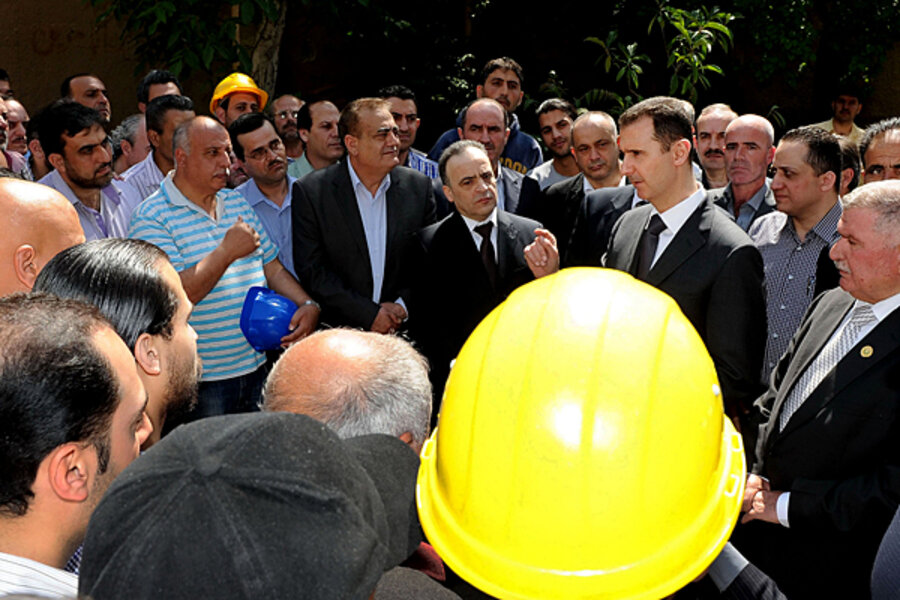Emboldened by military gains, Assad regime shows resilience
Loading...
| Beirut, Lebanon
During more than two years of a debilitating civil war, Syrian President Bashar al-Assad has consistently defied predictions of an imminent downfall, and his regime is showing remarkable resilience.
The Syrian Army has scored tactical successes against rebel forces across the north, west, and south of the country, dismaying the opposition and possibly postponing a planned rebel “spring offensive" to storm the regime stronghold of central Damascus.
“Bashar’s game plan is to shoot it out till the end, bring out the worst in his enemies, and rally minorities around him in a regime redoubt,” says Andrew Tabler, a Syria expert at the Washington Institute for Near East Policy.
It is a plan that for now appears to be working, as “the end“ becomes harder to see. Mr. Assad has managed to retain the loyalty of most of his Alawite community, the heterodox Shiite sect that forms the backbone of the regime, as well as other religious minorities who have watched with trepidation the rise of extremist rebel factions, such as the Al Qaeda-linked Jabhat al-Nusra, which is calling for a state governed under sharia (Islamic) law after Assad’s ouster.
Assad also can rely on the so-far unwavering support of international and regional backers – Russia, Iran, Shiite elements inside Iraq, and the Lebanese Shiite militant organization Hezbollah.
"Syria has real friends in the region and the world who will not allow Syria to fall into the hands of America or Israel or the Takfiris," Hezbollah leader Sheikh Hassan Nasrallah warned the Syrian opposition in a televised speech this week. Takfiris is a name given to some extremist Sunni Muslim jihadists who treat other religions as apostate.
Although Mr. Nasrallah has admitted that some members of his organization are defending Shiite villages in Syria, he hinted that Assad’s Lebanese and Iranian allies could intervene more heavily in the future.
“What do you imagine would happen in the future if things deteriorate in a way that requires the intervention of the forces of resistance in this battle?” he asked.
Meanwhile, the bickering political opposition still has not managed to form a united and coherent front able to win over fence-sitting Syrians and inspire the full commitment of the international community. The dozens of armed opposition groups, while motivated in their struggle, remain generally ill equipped and increasingly split along ideological lines and rivals for funds and weapons.
“We have a problem with Jabhat al-Nusra because some of them used to be killers and thieves, and then suddenly they became [religious] fanatics overnight because they get weapons and money [from foreign sponsors],” says Abu Assy, a Syrian opposition activist living in hiding in Lebanon.
The complicated road to Damascus
A diplomatic report prepared in early April for a European government noted that the Assad regime had conducted a counteroffensive in the Damascus area to prevent rebel forces from reaching positions from which they could launch a final push on the city center.
“According to regime reports, they [the Syrian Army] have achieved such progress that the rebel forces cannot launch an attack on the [city] center, but other observations do not support that the tactical situation has changed,” the report says.
However, since the diplomatic cable was written, government forces have seized the town of Utaibe, east of Damascus, severing a key weapons supply line from Jordan to rebel groups deployed around the southern and eastern edges of the city. The Syrian Army also seized the town of Jdeidet al-Fadel, southwest of Damascus, that sits on the highway linking the Syrian capital to the Golan Heights.
The capture of the town, where as many as 100 people were reportedly killed, appears to have frustrated the rebels' plan to drive northeast from the town of Quneitra on the Golan Heights toward Damascus in an attempt to get in position for a final push on the city center.
Sweeping success
In western Syria, the Syrian military, accompanied by Hezbollah fighters, has launched an offensive to retake a string of rebel-held villages just west of Qusayr, a town lying between the border with north Lebanon and Homs, Syria’s third largest city. The capture of the villages leaves the Syrian Army well placed to mount an attack against Qusayr itself, a mainly Sunni town of some 30,000 residents that has been in rebel hands since February 2012.
Qusayr lies beside the main highway that links Damascus to Homs and on to the Port of Tartous on the Mediterranean and the mountainous hinterland that is home to the bulk of Syria’s Alawite community. If Qusayr is recaptured by the regime, the military will be in a strong position to seize the last two quarters of Homs that lie in rebel hands.
Opposition activists said Thursday that the Syrian Army had seized Wadi al-Sayeh in central Homs, effectively cutting off the rebel-held districts of Khaldiyah and the Old City from each other. If Homs falls under regime control once more, the Syrian Army could then focus on regaining control over a stretch of highway between Damascus and Homs where rebels have a strong presence.
In the northern Idlib Province, the Syrian Army recently broke a months-long siege of the Wadi Deif military base outside the town of Maarrat al-Numan by outflanking rebel factions.
Still, neither side is strong enough to decisively overcome the other, analysts say. The Assad regime has bought itself time by rolling back some rebel gains and demonstrated a determination to prevail. But the international outcry over alleged chemical weapons use and the related mounting pressure on the Obama administration to intervene more forcefully suggest that the Assad regime could face tougher challenges in the months ahead.
"He has no choice but to keep fighting," says Joshua Landis, director of the Center for Middle East Studies at the University of Oklahoma and author of the influential Syria Comment blog. "This is the unfortunate dilemma. For both sides, this is a zero-sum conflict."







